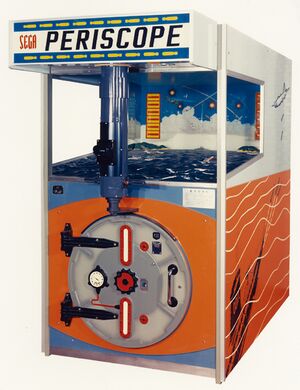Difference between revisions of "Electro-mechanical arcade games"
From Sega Retro
Scarred Sun (talk | contribs) (Created page with "thumb|right|''[[Periscope'', an example of an early Sega electro-mechanical arcade game. ]]'''Electro-mechanical arcade games''' (often abbrevi...") |
|||
| (48 intermediate revisions by 4 users not shown) | |||
| Line 1: | Line 1: | ||
| − | [[File: | + | [[File:Periscope cabinet.jpg|thumb|right|''[[Periscope]]'', an example of an early Sega electro-mechanical arcade game.]] |
| − | ]]''' | + | In the mid-20th century, '''electro-mechanical arcade games''' ('''EM''' games) were a staple of amusement [[arcade]] venues across the world. As the name suggests, these are commercial products, typically using simple electric circuits to move physical objects in order to simulate a game - an evolution of slot machines, pinball tables and Pachinko machines (as well as purely mechanical games), and which rose to prominence after the end of World War II. |
| − | + | Numerous amusement companies designed and manufactured coin-operated EM games between the early 1950s and late 1970s. [[Sega]] began producing games in the early 1960s, with the 1966 release of ''[[Periscope]]'' emerging as their first successful EM venture. Until the mid-1970s, the company structured itself around this market. | |
| − | + | In the late 1960s, "video projection" electro-mechanical games began appearing, with the likes of Sega's ''[[Duck Hunt]]'' (1968) dropping physical moving targets in favour of projected animated images, helping to set the tone for the first half of the 1970s. With the advent of more complex and reliable "video games" - those which use a combination of [[wikipedia:Solid-state electronics|solid-state electronics]] to draw a picture on a television screen, Sega became less focused{{magref|cb|1975-07-05|229}} on its EM operations, ending with the release of ''[[Plinker's Canyon]]'' in 1976. | |
| + | |||
| + | A number of arcade video games were inspired by electro-mechanical arcade games (particularly the "video projection" type) during the 1970s, until video games eventually replaced electro-mechanical games with the arrival of ''[[Space Invaders]]'' (1978). Due to a reliance on physical moving parts (and by extension, high maintenance costs), all types of electro-mechanical arcade games are difficult to find outside of museums, with most being taken out of service in the early 1980s. | ||
| + | |||
| + | ==References== | ||
| + | <references/> | ||
[[Category:Arcade systems]] | [[Category:Arcade systems]] | ||
Latest revision as of 09:02, 3 September 2020

In the mid-20th century, electro-mechanical arcade games (EM games) were a staple of amusement arcade venues across the world. As the name suggests, these are commercial products, typically using simple electric circuits to move physical objects in order to simulate a game - an evolution of slot machines, pinball tables and Pachinko machines (as well as purely mechanical games), and which rose to prominence after the end of World War II.
Numerous amusement companies designed and manufactured coin-operated EM games between the early 1950s and late 1970s. Sega began producing games in the early 1960s, with the 1966 release of Periscope emerging as their first successful EM venture. Until the mid-1970s, the company structured itself around this market.
In the late 1960s, "video projection" electro-mechanical games began appearing, with the likes of Sega's Duck Hunt (1968) dropping physical moving targets in favour of projected animated images, helping to set the tone for the first half of the 1970s. With the advent of more complex and reliable "video games" - those which use a combination of solid-state electronics to draw a picture on a television screen, Sega became less focused[1] on its EM operations, ending with the release of Plinker's Canyon in 1976.
A number of arcade video games were inspired by electro-mechanical arcade games (particularly the "video projection" type) during the 1970s, until video games eventually replaced electro-mechanical games with the arrival of Space Invaders (1978). Due to a reliance on physical moving parts (and by extension, high maintenance costs), all types of electro-mechanical arcade games are difficult to find outside of museums, with most being taken out of service in the early 1980s.
References
Subcategories
This category has the following 14 subcategories, out of 14 total.
1
- 1962 electro-mechanical arcade games
- 1965 electro-mechanical arcade games
- 1966 electro-mechanical arcade games
- 1967 electro-mechanical arcade games
- 1968 electro-mechanical arcade games
- 1969 electro-mechanical arcade games
- 1970 electro-mechanical arcade games
- 1971 electro-mechanical arcade games
- 1972 electro-mechanical arcade games
- 1973 electro-mechanical arcade games
- 1974 electro-mechanical arcade games
- 1975 electro-mechanical arcade games
- 1976 electro-mechanical arcade games
Pages in category "Electro-mechanical arcade games"
The following 71 pages are in this category, out of 71 total.